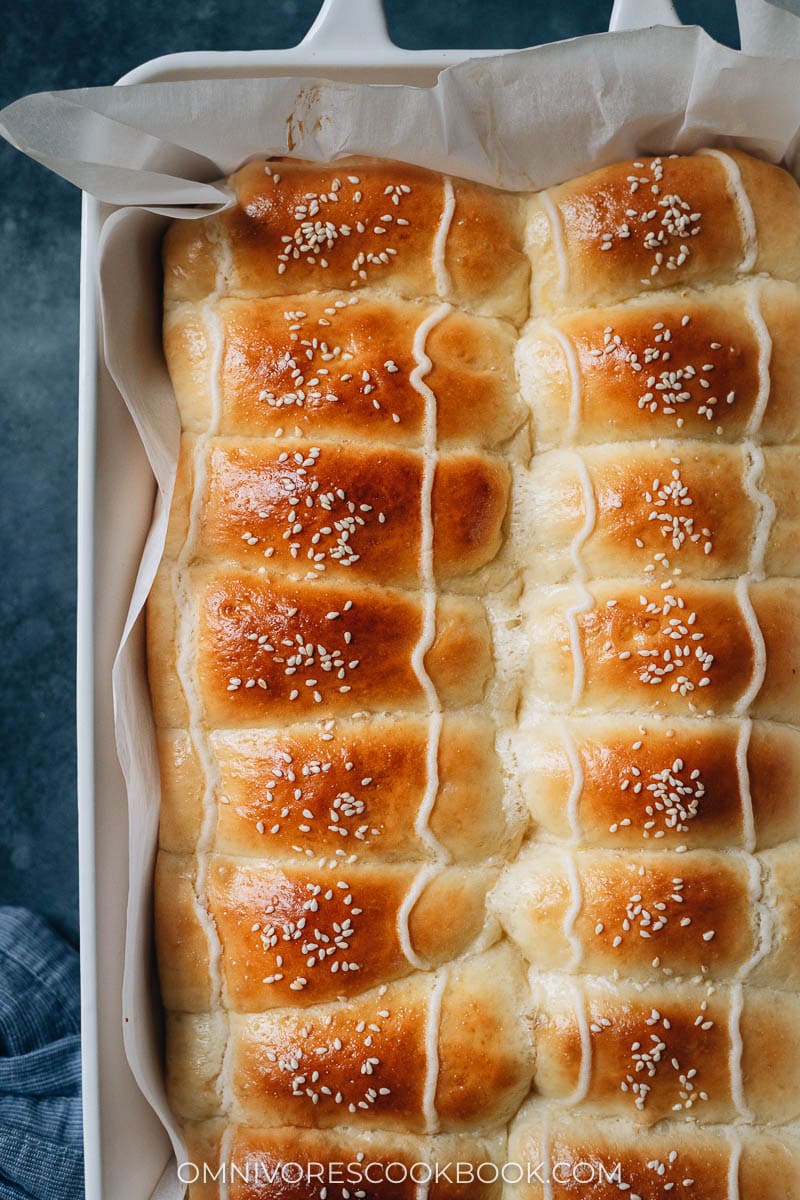
After moving out of the city, one of the things I’ve missed most is the access to Asian bakeries. I constantly crave tasty baked goods such as Hot Dog Buns, Hong Kong Egg Tarts,Pineapple Buns, Egg Cakes, and of course, coconut buns.
Coconut buns, or cocktail buns, are a light yet indulgent bread that features a very fluffy texture and a buttery filling. There are many approaches to making coconut buns. Some bakeries use a dryer filling with plenty of shredded coconut. Some are more generous with the butter, which makes the buns more decadent. I prefer the more buttery filling, myself.
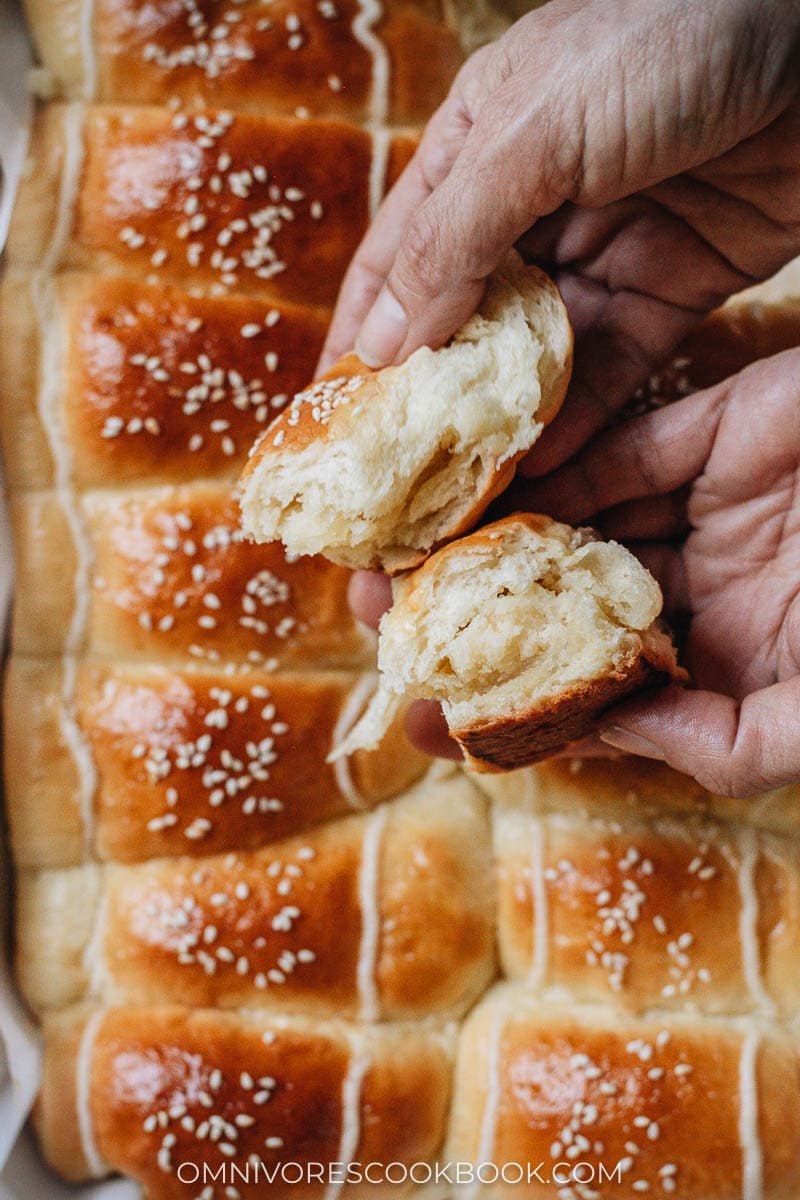
New Cookbook – Mooncakes and Milk Bread
I’ve tried out a few coconut bun recipes but most of them are not as good as I expected. Until I saw the coconut bun recipe from the cookbook Mooncakes and Milk Bread by Kristina Cho. It is a book focused on baked goods from Chinese bakeries. Inside you’ll find sweet and savory baked buns, steamed buns, Chinese breads, unique cookies, whimsical cakes, juicy dumplings, and more.
Her coconut bun recipe caught my eye immediately. It uses plenty of butter, dry milk powder, and a bit of flour to create a thick buttery coconut filling, just as I expected. I was so happy with the result of these buns and could not wait to share them with you.
I also highly recommend Kristina’s cookbook if you’re interested in Asian baking recipes. I have quite a few recipes from the book that are on my to-cook list: taro leaf buns, Miso Corn Buns, Hot Dog Flower Buns, and Matcha and Jasmine Swiss Rolls.
How to make coconut buns
Prepare the dough
I put together this super simple milk bread dough recipe using a standard mixer. It is a very wet dough, so a mixer is highly recommended. If you decide to hand knead the dough, you might need to add more flour to make it workable.
- Add both wet and dry ingredients into the mixing bowl.
- Mix on low until the dough just comes together.
- Mix on medium speed. Stop to scrape down the sides if needed.
- Once done, the dough should be very soft and elastic. You can stretch out a piece of dough to form a semi-transparent sheet without breaking it.
- Cover the dough and let rest.
- The dough is ready to use once it has doubled in size.
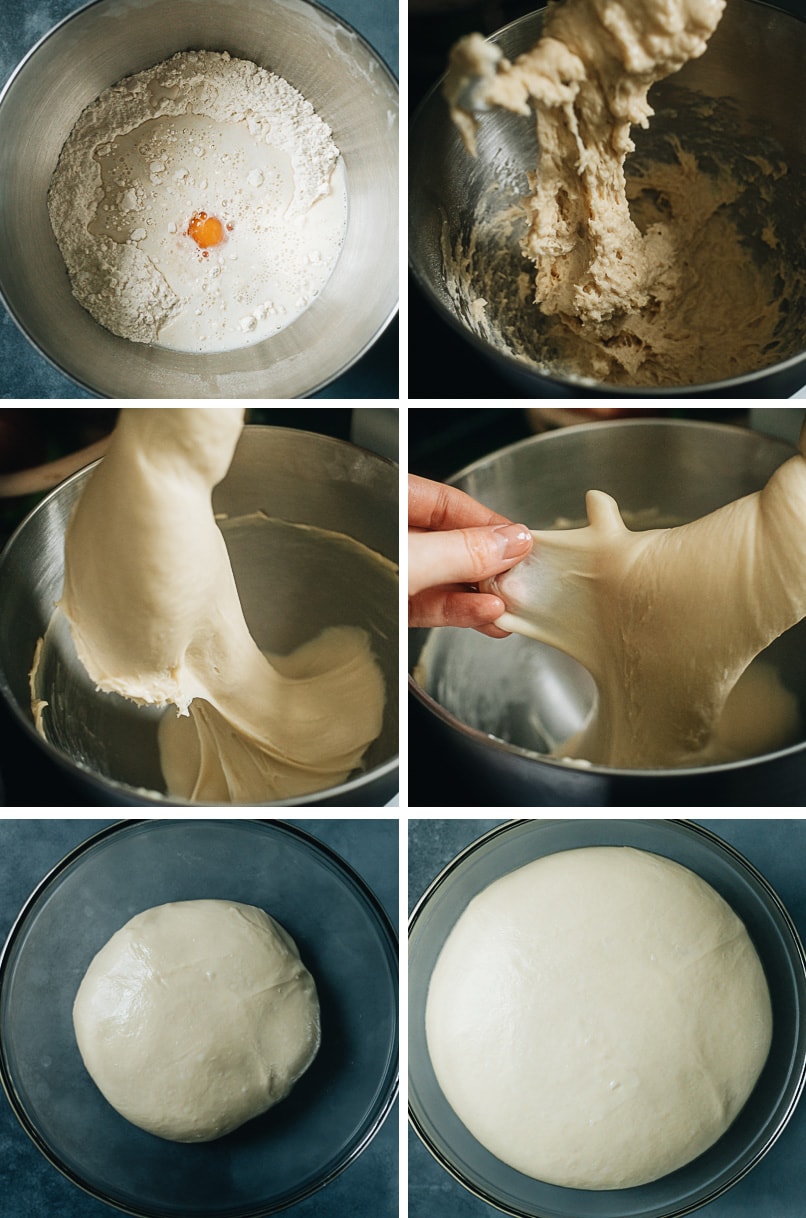
Make the coconut bun filling
While the dough is resting, you can prepare the filling. Simply mix up the ingredients and you will get a dry mass. I really like this filling because it usually does not require chilling and it’s easy to work with.
NOTE: if your room temperature is very low, the butter will solidify and make the filling crumbly. In winter, I prefer to put the filling bowl over my radiator to keep the filling warm. So it will be easy to shape later.
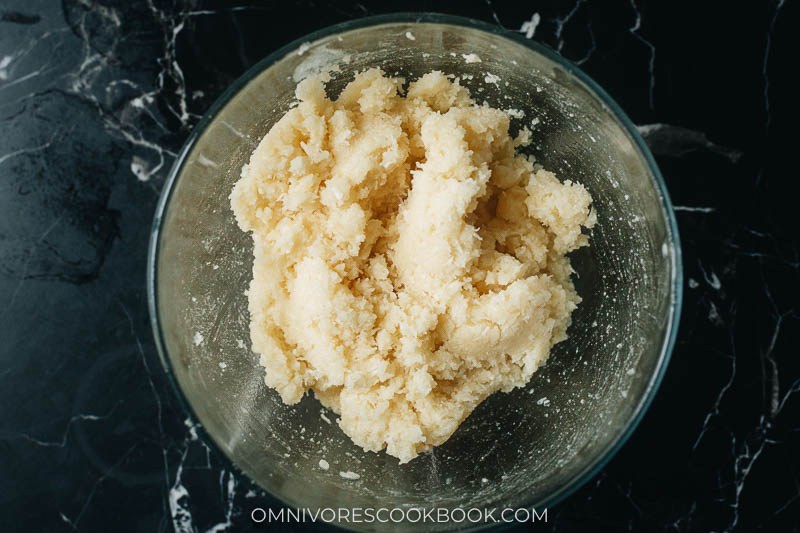
Coconut bun topping
To mimic the Asian bakery style, this recipe uses both an egg wash and a topping to create the lines (both from Mooncakes and Milk Bread).
For the topping, you can place the paste in a ziplock bag and cut off a corner and use the ziplock as a piping bag. However, do feel free to skip it if you like. It is more for decorative effect and does not affect the taste of the buns much.
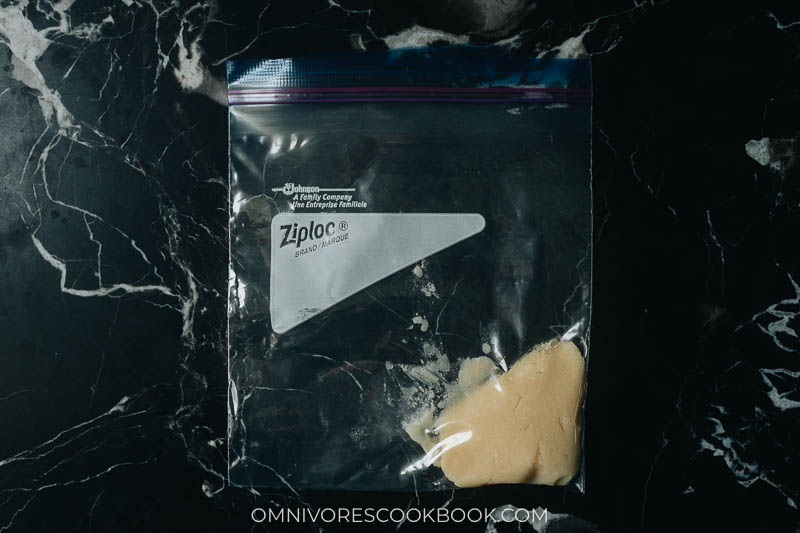
Assemble the coconut buns
Once your dough has doubled in size, you can start assembling the coconut buns.
- Divide the dough, then pinch each piece of dough together
- Use your hands to form a dome to gently roll and press the dough to shape it into a ball
- You should always cover the dough with plastic wrap to prevent it from drying out
- Roll out the dough into an oval shape, with a thicker center
- Add the filling in the center
- Wrap the dough around the filling and seal the dough
- Pinch the dough tightly so it won’t fall apart
- Cover the assembled coconut buns and rest again
- Brush with egg wash
- Decorate the buns with the topping
- Sprinkle with sesame seeds
- Bake until golden brown
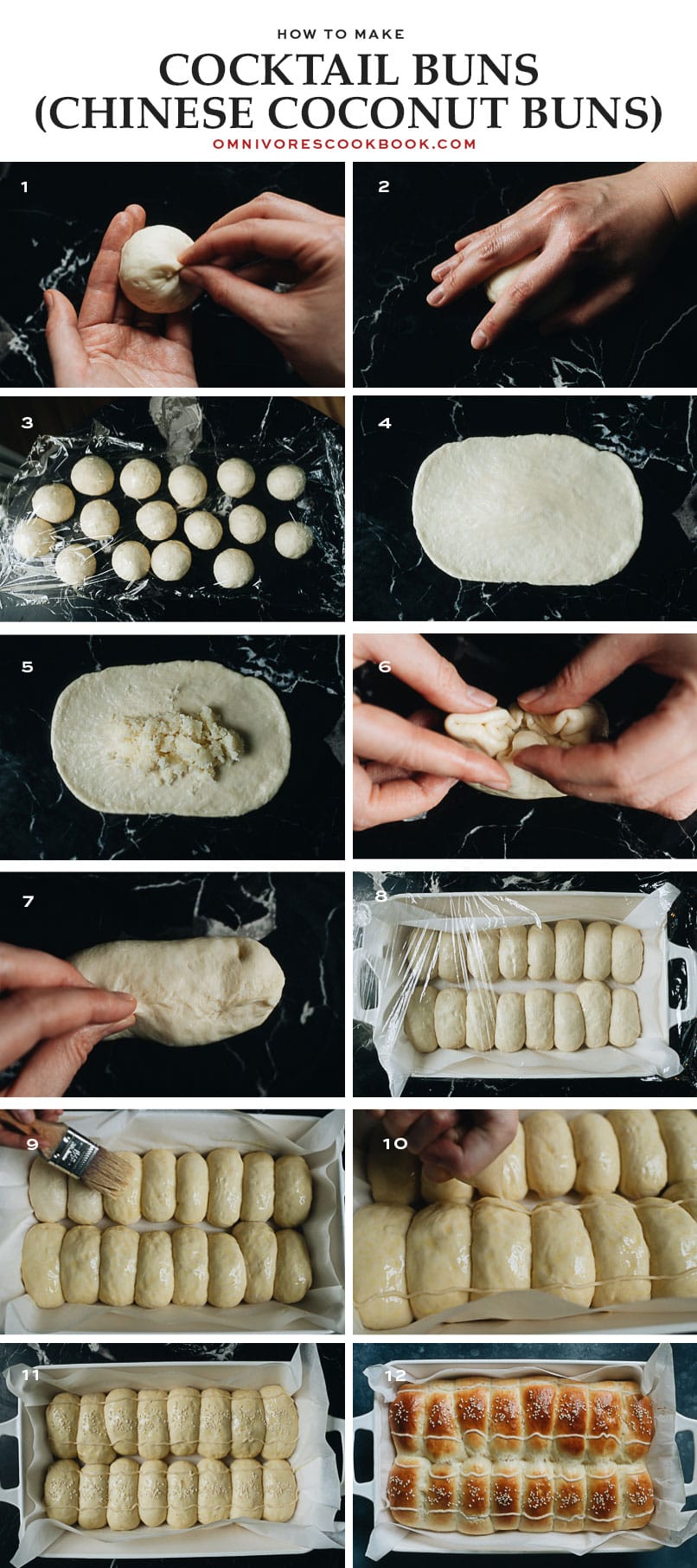
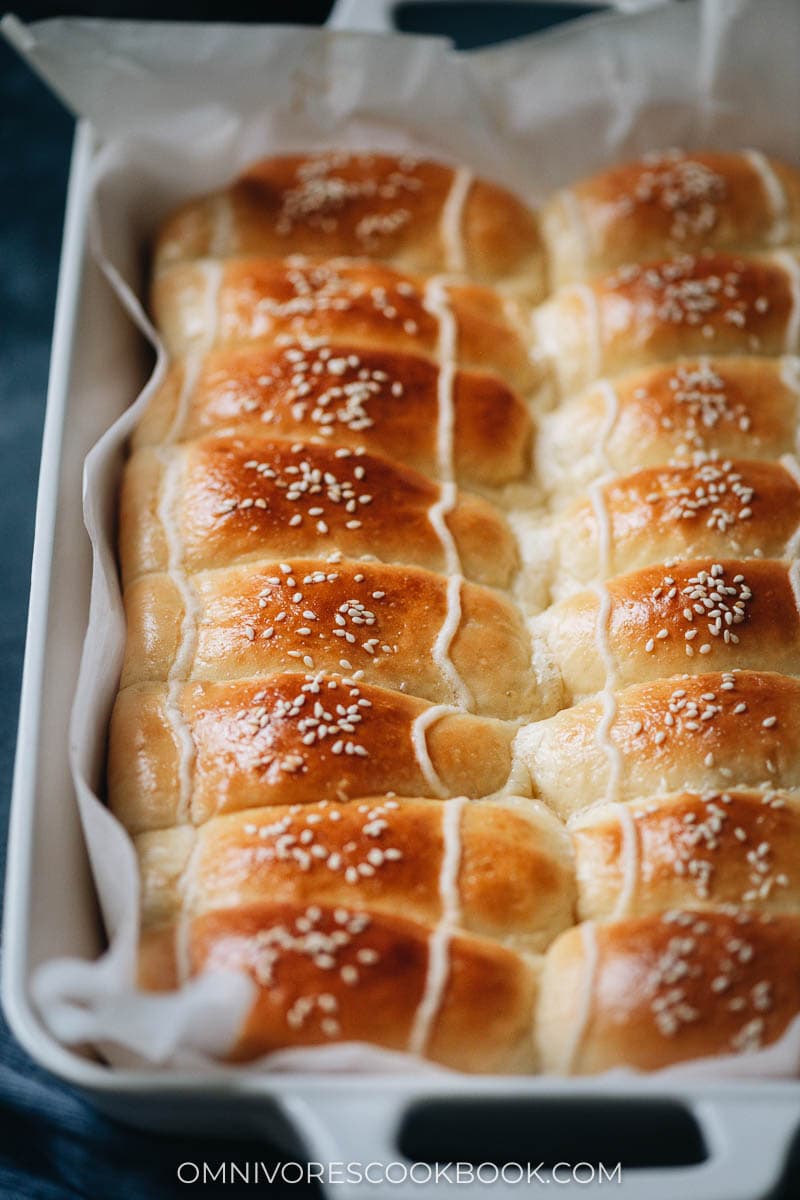
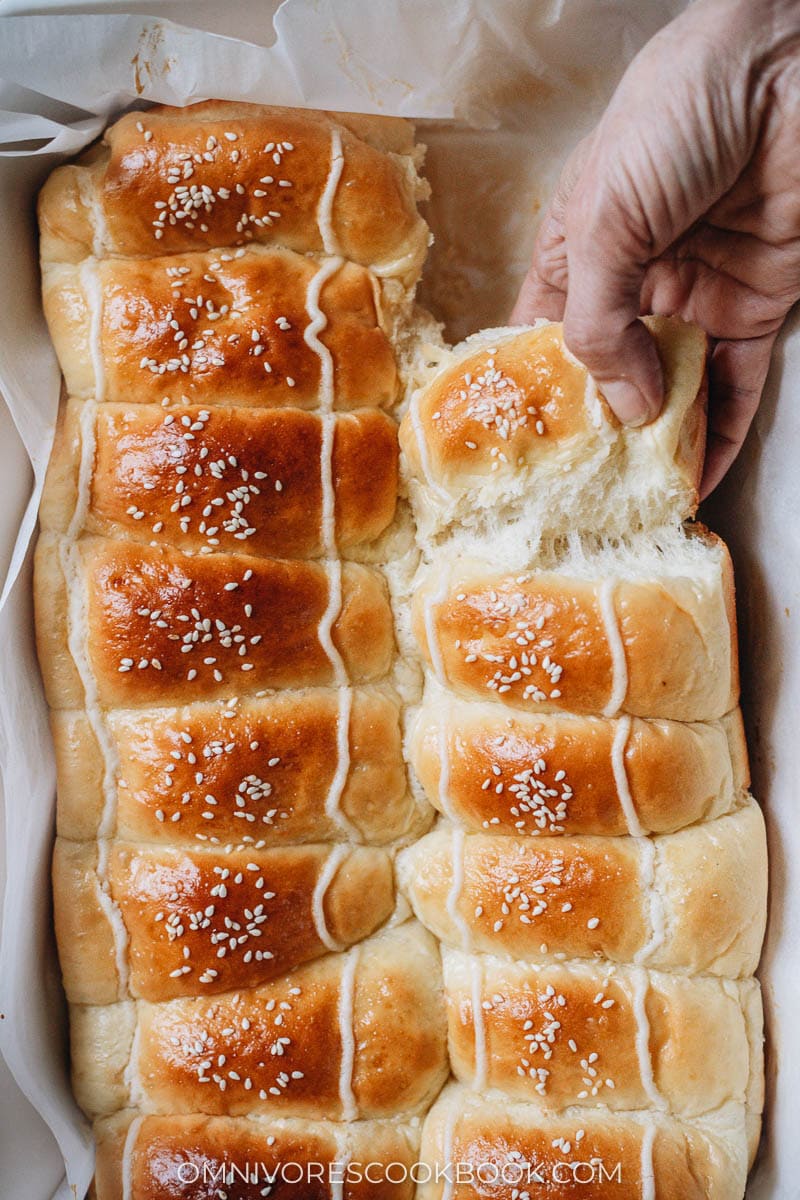
Baking sheet vs casserole dish
I’ve tried baking the buns on a regular baking sheet and in a casserole dish. If using a baking sheet, you will get oval buns that are mostly separated with a small part attached together. If using a casserole dish, the buns will be squeezed together. If you aren’t looking for perfect buns, the casserole dish method is quite forgiving and easier to work with.
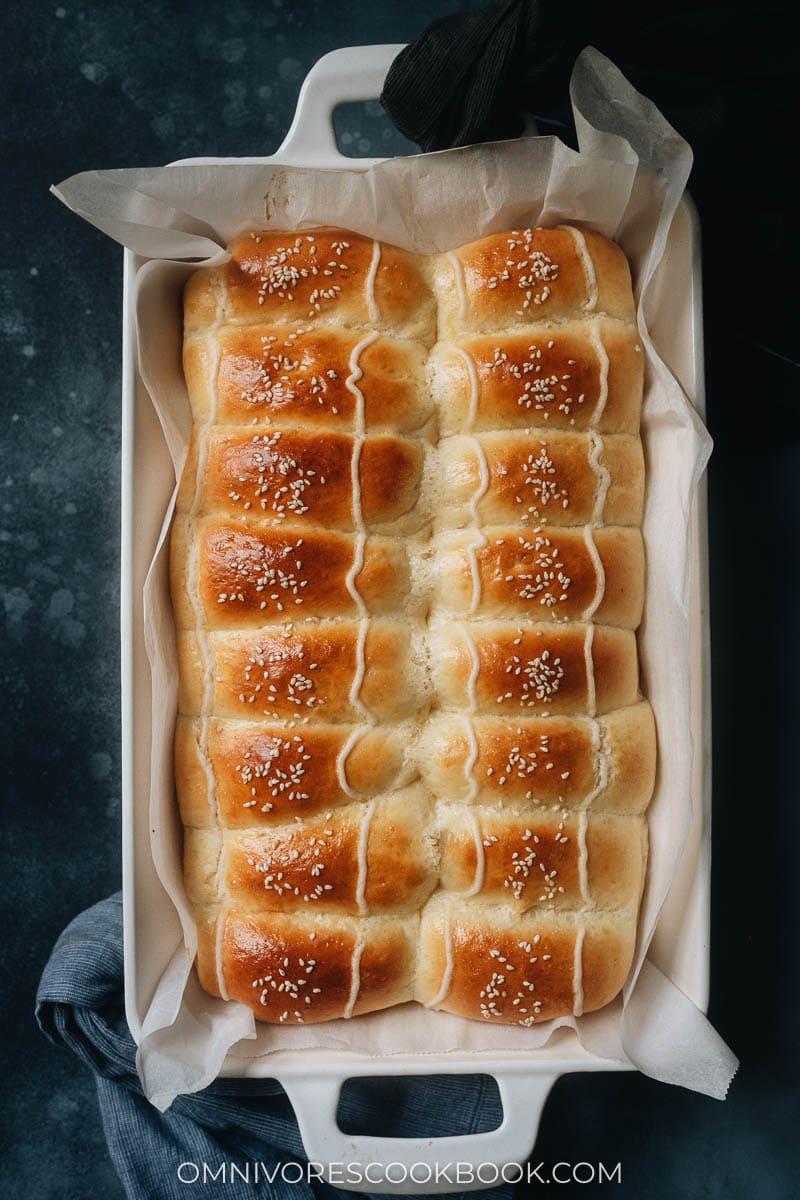
Afterthoughts
When I was testing the coconut bun recipe, there was one time I accidentally made a dozen buns with twice the amount of filling. Because I halved the dough but forgot to halve the filling. The result was SO GOOD! It felt like a decadent dessert and I loved how buttery and sweet the filling was. If you’re looking for a more balanced result, follow this recipe as it is. It makes a nice fluffy bread that I would eat for breakfast. If you’re looking for a dessert, try double the filling for a richer taste 🙂
I hope you enjoy these coconut buns as much as I do!
Chinese Cooking Made Easy
Are you new to this website? This free email series is a great place to start. I’ll walk you through a few of my most popular recipes and show you how and why they work. You’ll quickly start to cook better Chinese food in your own kitchen.
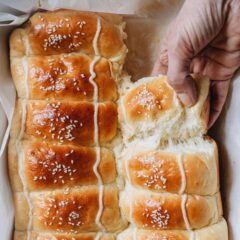
Chinese Coconut Buns (Cocktail Buns)
Ingredients
Dough
- 260 ml (1 cup + 1 tablespoon) milk , heated to 110°F / 43°C
- 1 1/2 teaspoons (6 g) active dry yeast
- 400 g (2 3/4 cups) bread flour
- 50 g (1/4 cup) sugar
- 1 g (1/4 teaspoon) salt
- 40 g (3 tablespoons) butter , melted
- 1 large egg
Filling
- 40 g (2/3 cup) unsweetened shredded coconut
- 85 g (6 tablespoons) butter , melted
- 30 g (1/4 cup) dry milk powder
- 50 g (1/4 cup) sugar
- 20 g (2 tablespoons) all-purpose flour
- 1 g (1/4 teaspoon) salt
Topping
- 21 g (1 1/2 tablespoons) unsalted butter , melt
- 18 g (2 tablespoons) all-purpose flour
- 10 g (1 tablespoon) confectioner’s sugar
Egg wash
- 1 large egg
- 1 tablespoon heavy cream (or milk)
- Toasted sesame seeds for garnish (Optional)
Instructions
To make the dough
- Combine the warm milk, a pinch of sugar (from the sugar you plan to use in the dough), and dry yeast in a small bowl. Set aside for 5 minutes for the yeast to activate. When it’s ready, the yeast should be bubbly.
- Add the flour, sugar, and salt to the bowl of a stand mixer and create a well in the center. Pour the activated yeast, melted butter, and egg to the well. Attach the dough hook. Mix on low until a shaggy dough begins to form. During mixing, stop the mixer and scrape the flour from the wall of the bowl if needed.
- Turn the speed to medium (setting 4) and knead for 15 to 20 minutes, until smooth and elastic. Observe the dough during the process. If the dough is too wet and cannot be gathered by the dough hook, sprinkle some flour, 1 teaspoon at a time, until the dough comes together. If it’s too dry, you can add a bit more milk. This is a wet dough. And it’s normal to have a small amount of dough stick to the bottom of the mixing bowl the whole time.
- Spray or grease a large bowl with a thin layer of oil (or butter).
- Once the dough is ready, gather it into a ball and place in the oiled bowl. Cover with plastic wrap. Rest until doubled, about an hour or so (It can take anywhere from 45 to 90 minutes depending on heat and humidity).
To make the filling
- Add all the filling ingredients into a medium-size bowl. Mix with a spatula until crumbly. You should be able to lift and shape the filling using your hands. If it’s too crumbly and dry to form, add a bit of melted butter. Set aside. (*Footnote 1)
Roll out the dough & 2nd rise
- Punch the fully risen dough down to deflate it. Transfer it to a clean working surface and knead briefly, until it returns to its original size.
- Cut the dough into 12 or 16 even pieces (*Footnote 2). You can use a scale to weigh each piece of dough so the buns will come out perfectly evenly sized. For 12 buns, it’s 65 g per piece or 49 g per piece if making 16 buns. Immediately cover all the dough with plastic wrap to prevent it from drying out.
- One piece at a time, pull and pinch the dough together at the top until the dough is rounded. Flip the piece so that the pinched part of the dough faces down on the working surface. Place your palm and fingers over the ball forming a domed cage. Roll the dough in small circular motions while applying light pressure to the dough. Set aside and cover again. Once all the dough is formed, let rest for 10 minutes before assembling.
Assemble the buns
- Line a 9” x 13” baking dish (*Footnote 3) with parchment paper.
- Flatten a piece of dough. Roll with a rolling pin into a 3”x5” (7cm x 12cm) oval shape, with thinner sides and a thick center. Scoop 1 heaping tablespoon of filling (if making 12 buns, use 1 scant tablespoon if making 16 buns). Place it in the middle of the dough (*Footnote 4). Bring up all the edges of the dough to gather in the center, around the filling. Pinch all the dough together to seal the bun, forming an oval-shaped bun. Place on a parchment-lined baking tray and cover with plastic, repeat with the remaining buns.
- Once all the buns are formed, let rest for another 30 to 40 minutes. While the buns rise, preheat the oven to 350°F (176°C) and prepare the topping.
Prepare the topping
- Combine the topping ingredients in a small bowl. Mix until it forms a smooth paste. Transfer it to a small ziplock bag and press it towards one corner and squeeze out as much air as possible. Seal the bag, and cut 1/4” (6mm) of the tip off.
Prepare the egg wash
- Make the egg wash just before baking by combining the egg and heavy cream in a small bowl. Stir to mix well.
Bake the buns
- Once the buns have finished their second rise, brush gently with the egg wash. Pipe two strips across the short ends of the buns. Sprinkle with the sesame seeds if using. Bake for 20 minutes, or until golden brown. Transfer the dish to a wire rack to cool.
- Serve the buns warm or at room temperature.
Store and reheat
- Once the buns have cooled off completely, place them in a ziplock bag or airtight container. Store in the refrigerator for up to 3 days, or in the freezer for up to 3 months.
- To reheat the buns, you can either microwave them or bake them in a 300°F (148°C) oven until warmed throughout, 5 minutes for refrigerated buns or 10 to 15 minutes for frozen ones.
Notes
- If your room is very cold, the filling can become very firm and difficult to shape. In such cases, I usually place it in a warm spot such as on my radiator. It will loosen up the butter so it’s easier to work with as you shape the buns.
- I recommend making 12 buns if using a baking dish. I made 16 when I shot the images and found the buns got squeezed together too much. If using a baking sheet, either 12 or 16 works. I personally prefer to make a batch of 16 buns for a smaller serving size.
- You can use a regular baking sheet as well. The buns will come out more separated, with only a small part attached together.
- The filling should be crumbly and stiff, and you should be able to wrap it easily. If you’re looking for the perfect shape, you can form the filling into a log before wrapping.
Nutrition

Did you make this recipe?
I’d love to hear how it turned out for you! Please take a moment to leave a 5-star rating ⭐️ and share your thoughts in the comments further down the page. It really helps others discover the recipe too.
The coconut bun filling and topping recipes are from Mooncakes and Milk Bread by Kristina Cho, described in my own words according to my cooking experience.

Laddavanh Chen
Hi,
For the filling and dough it calls for ‘butter’. Is this salted or unsalted?
Maggie Zhu
It is unsalted butter.
An
Your embedded videos make it very hard to look at the recipes, also they have 1 min ads so why would I watch those?
Recipe is good though, need to double up on the filling.
VM
This recipe is just what I was looking for. I used to get these near my house in California but now living on the East coast I really miss them. The recipe was very easy and they came out perfect! I doubled the filling which was just like the ones I used to eat. My only change would be to add less butter on the doubled filling(but they were still great). They are delicious and I will definitely be making them again.
Ruixi
Hi! Would it be possible to omit the egg and replace the butter with oil?
Maggie Zhu
I have not tested the recipe without the egg and using oil instead of butter. If you decided to try it out, definitely let me know how it goes!
Paula Wong
Can this be made with gluten free flour and gluten free bread flour?
Sandy
Hi! Can’t wait to try this! Do you think it would work with whole wheat bread flour? Thanks!
Roxie
I don’t have any powder milk for the filling. Would it be okay to use regular milk ?
Maggie Zhu
Regular milk will make the filling quite wet and difficult to assemble. You should skip it if you don’t have milk powder.
Lisa
Hi!! Would it be possible to add fresh yeast instead of dry yeast ? Thank you!
Maggie Zhu
Yes you can. If using fresh yeast, you need to use 12 g instead of 6 g. The cooking process is the same.
Paula
Hi! Can this recipe be done with fresh yeast instead of dry?
Maggie Zhu
Yes! You can use fresh yeast, but you need to double the yeast (use 12 g instead of 6 g). The cooking process is the same.
Barbara
Milk bread is sooooo good and make it frequently for rolls. However, I really like the idea of a filling, but my family is not interested in coconut. What about Nutella or blueberries or any other suggestions?
iplumzer
Hi! Thank you for this recipe. Do you know if it’s possible to knead the dough by hand? I don’t have a stand mixer. Thank you!
Maggie Zhu
You can knead the dough by hand. It is a very wet dough, so you might need a dough scrape when putting it together. And it sticks a lot. If it is very hard to come together, you can add some flour. I’ve tried making this by hand before and the result was good, even if you need extra flour.
JayZecky
OMG!! This is better than any bakeries’ in Chinatown. Thank you for your recipe. My wife said it was super-easy to make. No more buying from the stores. Thank you for sharing!
TC
Thanks for the tip to double the filling! I always get mad when I buy these at a bakery and it’s mostly bread with very little filling! Baking them myself is the perfect way for me to ensure the ratio I like!
Maggie Zhu
Yes! My friend said she likes the regular filling because the bread is more fluffy, but for me the double filling always win 🙂
Elise
Thanks for the detailed instructions and pictures. I made the recipe as written, using a scale. Perfect.
Anna K
Oh, my! The bread came out perfect and was SO FLUFFY! This was EXACTLY what I’ve always wanted from milk bread recipes. I gave one to a friend whose never had this kind of bun–she took one bite, paused, and asked if I had purchased it from a bakery!
All the detailed tips/notes/photos were absolutely key to success here. I almost didn’t knead the dough enough, but I went back to the photos for reference. I ended up making 1.5x the filling, but really could have doubled it for the full batch. I also wish I had doubled the topping because I didn’t have enough to make the 2 lines on each side. My ziplock broke when I tried to pipe the topping, so I ended up rolling them into thinnish logs and draping them.
The buns froze well, as stated! The buns takes some work to make, so I highly recommend making the batch and just freezing half. Thank you, thank you, thank you for sharing this recipe!
Maggie Zhu
So happy to hear you tried this one out and liked the result! And many thanks to your kind words and leaving a positive review 🙂
Ellyna eng
Hi. Is the coconut fresh shredded coconut or dry desiccated coconut ? Thabk you
Maggie Zhu
It is dry desiccated coconut, the smaller the flakes the better.
Lena
The bread didn’t come out fluffy. Any recommendations?
Maggie Zhu
I think the first thing you want to check is if the yeast you use is still fresh. If you have opened a pack for a long time, it might not as potent.
If the dough rises without any issues, the resting time also depends on your room temperature and other condition like humidity. You might need a longer proofing time if the room is on the colder side.
If you used cups instead of grams for measurement, the ratio could be off. The dough should be very wet and sticky. If using cups, you might end up with more flour and make the dough too dry.
Anita
I can’t find the sugar amount for the dough
Maggie Zhu
So sorry about that! I just added it to the list.
Selina
You mentioned in the instructions -sugar for the dough. I do not see how much sugar for the dough.
Maggie Zhu
Sorry about the confusion. It got lost when I copy pasted the recipe. I just added it back and now it’s the correct list.
Sheila
Would it be ok to use all purpose flour? I don’t have bread flour and too much all purpose flour on hand at the moment.
Maggie Zhu
You can use all purpose flour. It will require less liquid because AP flour will absorb less. What I would do is to follow the recipe. When you knead the dough, add more flour if the dough is too wet.
Y-Yen L.
Would it be possible to sub in a milk substitute in this recipe?
Maggie Zhu
I think it’s possible. I would use almond milk or soy milk because these two has a higher fat and protein content, which is closer to milk. The end result will likely be a bit different but the bread should work. You also need a substitute for the milk powder in the filling, which adds thickness and a nice aroma.